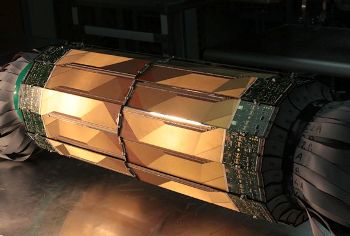Jan 22 2016
The charge of antihydrogen — the antimatter counterpart of hydrogen — is neutral, confirms a new study involving University researchers and published in this week’s Nature.
 The ALPHA Detector which was built at Liverpool
The ALPHA Detector which was built at Liverpool
Antimatter is thought to have appeared in a quantity equal to that of matter after the Big Bang, but, intriguingly, it appears to be absent from the observable Universe.
Recently it has become possible to study artificially created atoms of antihydrogen in an effort to search for possible differences in behaviour between matter and antimatter.
According to the Standard Model of particle physics, the charge of antihydrogen should be the same compared to its matter counterpart, hydrogen, known to be neutral to a very high precision, but this has been difficult to test because producing antimatter and measuring its properties is experimentally very challenging.
The ALPHA -experiment has now improved the measurement of the charge of antihydrogen by a factor of 20 in precision, compared to previous measurements. Since the charge of the antiproton (the antimatter counterpart of the proton) is known to similar precision, this result also helps to refine the bound on the charge of the positron (the antimatter counterpart of the electron).
A Liverpool designed and built Silicon Vertex Detector (SVD) which is capable of ‘seeing’ inside the neutral antimatter trap, and can tell exactly where and when the antimatter has met its matter counterpart is at the heart of the experiment.
Professor Paul Nolan, the Liverpool team leader, said: “This experiment shows we’re able to draw very spesific conclusions from a very small amount of antiatoms”.
Dr Petteri Pusa, who is in charge of Liverpool-ALPHA CERN operations, added: “These findings were only possible to obtain by the data recorded by the Liverpool build SVD”.
Mostafa Ahmadi, a PhD candidate working at ALPHA, said: “It is a privilidge to work in such multidiscplinary environment. This is all very hard work, but now we’re much looking forward to probing the anti-world with lasers”
The measurements constitute a test of the fundamental requirements of the Standard Model and may help address the long-standing question of why there appears to be so much more matter than antimatter in the observable Universe.